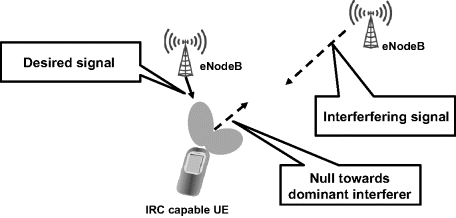12.3 Advanced LTE UE Receiver
Advanced UE receiver work follows the similar activity done earlier for HSPA UE receiver. Even though 3GPP defines a baseline receiver to be used to create performance requirements for a UE supporting advanced receiver, a particular receiver is not mandated for a UE. The baseline receiver agreed to be used for the simulations on the performance requirements is Minimum Mean Square Error (MMSE) – Interference Rejection Combining (IRC) receiver. The MMSE-IRC receiver has the capability to ‘reject’ the interference by creating a ‘null’ in the spatial domain towards the most dominant interferer, as was also discussed in [1]. Such an operation is illustrated in Figure 12.3.
Figure 12.3 The MMSE-IRC receiver principle.

Figure 12.4 shows the basic block diagram of an Advanced UE receiver for decoding PDSCH using Maximal Ratio Combining (MRC) and IRC principles. The received signal is down-converted to baseband in each antenna branch. For each symbol the Cyclic Prefix (CP) is first removed and the Fast Fourier transform (FFT) is performed on the block of samples. A separate channel estimation block performs the channel estimation based on common or dedicated reference symbols. MMSE-MRC or MMSE-IRC based algorithm equalizes the received symbols with the complex channel estimate. The equalized symbols are fed into the Log-Likelihood Ratio (LLR) calculation based ...
Get LTE Advanced: 3GPP Solution for IMT-Advanced now with the O’Reilly learning platform.
O’Reilly members experience books, live events, courses curated by job role, and more from O’Reilly and nearly 200 top publishers.

